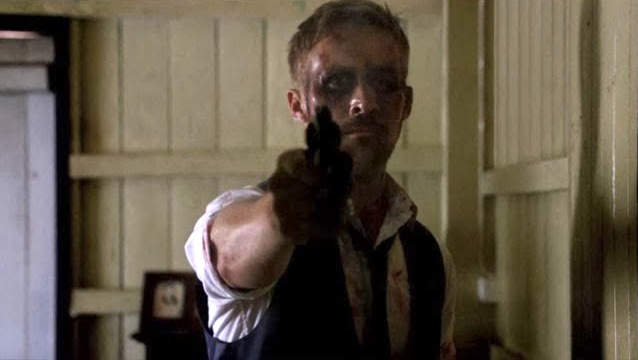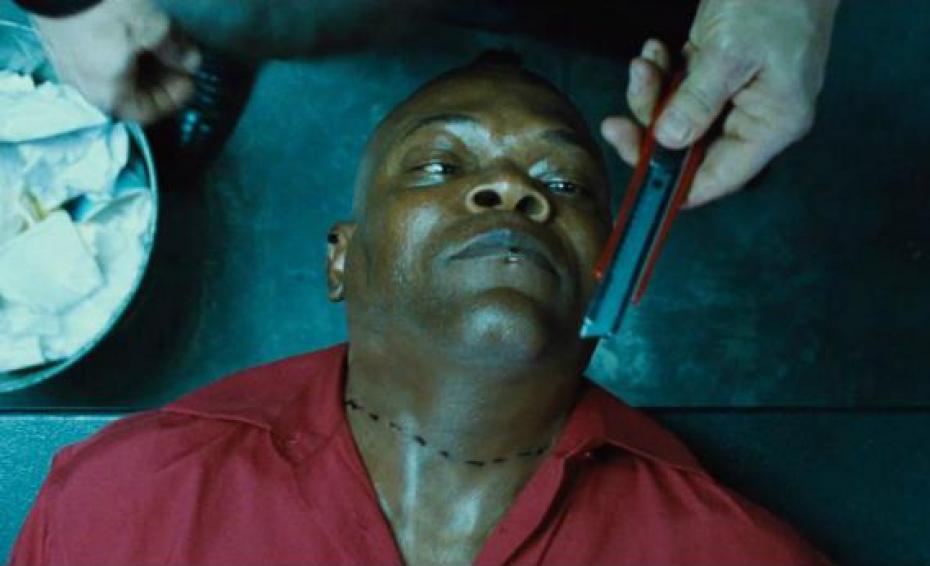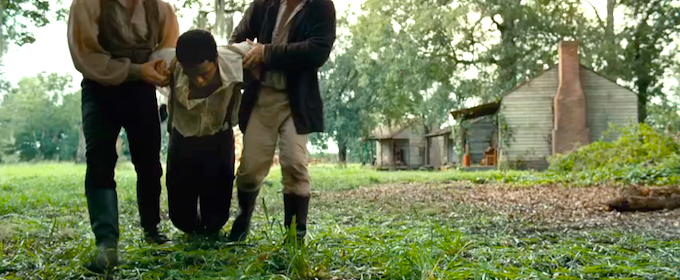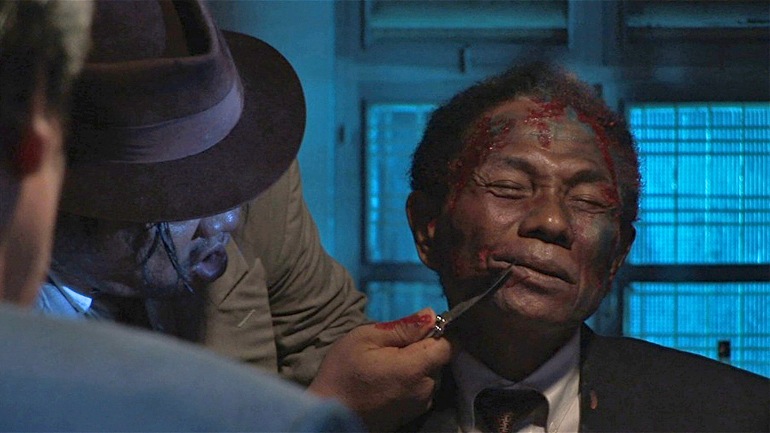Among this year’s bumper crop of contemporary, theatrically-released films, several titles stand out for their innovative, or just memorably disturbing exploitation of explicit violence and gore. These movies aren’t just titillating, though some do succeed at that ignoble goal. Films like The Act of Killing and A Touch of Sin are as distressing, and unnerving as they are because they use representations of extreme violence to re-enforce our relationship with images of violence as such. Other films, like the new Oldboy and Only God Forgives, are both unnerving and exciting for the way they express their creators’ conflicted views of onscreen violence. Here’s a list of ten 2013 films that left a mark.
10. Evil Dead
Like any horror film that uses gore to get asses in seats, the new Evil Dead titillates viewers with severed limbs, and gouts of blood. And since this Evil Dead is a remake of Sam Raimi‘s cult classic, the films’ creators had to hurt their characters badly/memorably enough to shake viewers out of their skepticism. So, while this new Evil Dead doesn’t need to exist, its creators deserve some recognition for finding new and nasty ways to burst viewers’ bubbles. It’s the least sophisticated item on this list, but Evil Dead will make you feel sick.
9. Bastards
Claire Denis‘s use of blood in Bastards is that much more disturbing because the film’s narrative is full of holes. As Manohla Dargis writes in her New York Times review, the film’s elliptical narrative is primarily about images, plummeting viewers into the action “in media res, forcing you to catch up. [Denis’s characters] already know what they’re doing, just like in real life.” We know enough about the plot to know why characters immediately do what they do, but Denis characteristically stresses the finite-ness of viewers’ knowledge by only explaining so much. So when Denis shows you blood trickling down a naked woman’s inner thighs, she’s confronting viewers, demanding that they accept their own powerlessness. In the film, violence against the nude bodies of women is, after a point, inexplicable. Denis asks viewers to accept that, while these imperfect, beautiful bodies are being brutalized, we shouldn’t always wish for them to be rescued.
8. Elysium
Like J.J. Abrams and Ron Moore, Neill Blomkamp fosters a sense of immediacy in both of his science-fiction films through Greengrassian hand-held photography. It’s intense! And sometimes out-of-focus. More effectively, Blomkamp really flogs Matt Damon throughout Elysium. For all the pain Damon goes through, Elysium might as well be called The Passion of Cyberpunk Jason Bourne. His character goes through several circles of body-horror hell, from internal damaged caused by radiation exposure, to bone-crushing pain caused by Damon’s Gibson-esque exoskeleton. Other aspects of Elysium‘s simplistic haves-vs.-have-nots take-away aren’t nearly as effective. But Blomkamp’s nasty imagination runs roughshod all over of his film’s unfortunate star, lending Elysium some considerable weight.
7. A Touch of Sin
Dargis hit the nail on the head when she described Jia Zhangke‘s latest as, “a Hobbes-ian war of all-against-all” in the New York Times. Jia’s film is an anguished protest against the apathy and commodification he finds so pervasive in modern Chinese culture. Divided into four stories, A Touch of Sin is a collective howl. And to show how powerless the revenge-seeking killers are in their lives are, Jia films events in engrossing wide-angle shots. He hyper-realistically highlights the fleet, sickening sounds of bodies being broken apart. And after a character dies, the camera surveys their body, highlighting signs of its collapse (blood trickling from under an outstretched hand, holes in a victim’s chest). A Touch of Sin is a tantalizingly beautiful gut-punch.
6. Only God Forgives
Like Valhalla Rising before it, Only God Forgives is a product of director Nicolas Winding Refn‘s love of seventies grindhouse films. But while Valhalla Rising has earned comparisons to The Last Movie, Only God Forgives is as violent, and archly funny as The Holy Mountain. Refn dedicated his film to Holy Mountain director Alejandro Jodorowsky because they’re friends in real life (Jodorowsky gives Refn semi-regular tea readings). But violence is ritualized and deployed in both Only God Forgives and The Holy Mountain in equally arcane ways. In both films, the mutilation of bodies, especially of the face in Forgives, violently pierces the veil of the film’s “reality.” It’s an alienating, Grand Guignol approach, one that uneasily slips from humor to horror, and back. Only God Forgives is, in that sense, simultaneously hyper-realistic, and cartoonishly gory. It’s not an easy film to pin down, but whether you love it or hate it (and many hate it), Only God Forgives is bound to strike a nerve.
5. Drug War
Master action filmmaker and genre jack-of-all-trades Johnnie To‘s Drug War is arguably his bleakest movie. It’s a black-as-night policier populated by crooked cops, desperate crooks, and grotesque drug users. And it climaxes with a Wild Bunch-worthy shoot-out in front of a crowded playground. Since almost everybody dies in this scene, To’s characteristically playful, nigh-balletic style feels that much more ghoulish. Bodies involuntarily twitch, flop, and dance about because To wants people to see any body involved with drugs as a body in pain. There’s the deaf-mute drug-manufacturers, characterized by agonized yelping; and the tortured, death-rattle laughter of a dealer named Ha-Ha; and all the corporeal punishment Louis Koo’s reluctant informant suffers through, from strip searches to the death penalty. If Drug War weren’t so compulsively entertaining, it would be the most devastating anti-drug PSA ever.
4. Oldboy
Spike Lee’s remake of Chan-wook Park’s adaptation of Garon Tsuchiya and Nobuaki Minegishi’s manga is nothing if not idiosyncratic. In interviews, Lee has said that he did not want the violence in his Oldboy to be “cartoonish,” but he does revel in violence in several key scenes. For example, he and screenwriter Mark Protosevich let their collective freak flag fly by making a traumatic flashback even more violent than it was in the first film. Lee films Sharlto Copley’s memories of being abused in a long tracking shot that culminates with an attempted multiple murder-suicide. CGI brains fly from the back of one character’s head in this scene, but only after Copley’s character unbuckles his belt, suggesting he is also being molested by his father. The way Lee and Protosevich up the ante in this scene says a lot about the film’s conflicted, but in no way innocent or naive perspective. This is a film that comes down hard on Josh Brolin’s “primitive” salaryman, a corporate grunt that has to live with his mistakes rather than take it out on his body. The film’s finale is that much more brutal because, unlike Park’s original, it’s not nearly as bloody. Lee’s use of violence is typically fascinating because it’s tortured: he doesn’t know how to condemn violence without exploiting it.
3. The Counselor
The Counselor sees Ridley Scott in fine form, mostly because screenwriter Cormac McCarthy’s bullishly unwieldy screenplay lets Scott be as perverted as he wants to be. Here, Scott has ice in his veins, and cynicism in his heart, and it shows in the film’s devastating representations/consideration of violence, especially the now-infamous bolito scene, and the highway beheading. The fact that characters talk endlessly about violence makes the scenes where people are graphically murdered and/or tortured that much more frightening. The Counselor uses a generic drug deal gone bad plot to stress that Evil—the idea of pure, unmitigated Evil—is real. And while that notion is ridiculous, the film is fairly successful at showing how compartmentalized people that commit, or even participate in acts of violence can be. You can see it in the scene where John Leguizamo shows and explains to Breaking Bad‘s Dean Norris what a “passenger” is, and the scene where Michael Fassbender realizes, without looking at its contents, that the Mexican drug cartel has made a snuff film of/starring his fiance. In the hands of any other director, McCarthy’s material would have clanged dismally. But thanks to Scott, The Counselor is one of the most effective moral tales of the year.
2. 12 Years a Slave
In 12 Years a Slave, director Steve McQueen characteristically emphasizes body language as a means of expressing his characters’ peril. Watching the film is accordingly a harrowing experience because McQueen’s characters express themselves through physical pain, and discomfort. There’s the nerve-shredding scene where Chiwetel Ejiofor twists at the end of a short noose while bystanders do nothing. And there’s the equally brutalizing scene where Ejiofor’s character reluctantly whips a fellow slave until Michael Fassbender’s drunken slave-owner intercedes. The film’s protagonists are their circumstances: they are their bodies, and their bodies are always uneasy. McQueen fetishistically highlights long pauses that reveal character-defining uncertainty, and group power dynamics. In this way, he’s very good at working viewers over, and 12 Years a Slave does have a happy ending, it’s also consistently and immediately devastating.
1. The Act of Killing
Joshua Oppenheimer’s experimental documentary is as disturbing and exciting as it is because, as skeptical film critic Michael Sicinski argued, it is about the primacy of images. By re-enacting, and then re-viewing their war crimes, Indonesian killers like Congo Anwar relived parts their lives, only now as victims, not murderers. Oppenheimer allowed Anwar to simulate versions of his killings, and the subsequent nightmares they provoked. Watching Anwar slowly empathize with his victims, from thoughtless swagger to tearful resentment, is remarkable. This is especially true of the scene where Anwar shows footage of a mock interrogation to his grandsons. He tries to dismiss the images he filmed as fiction: “Look, grandpa is sad!” But soon, when he’s watching the footage alone, he breaks down. Oppenheimer’s images establish the potency of represented violence, not just to titillate, but to agitate for new understanding.
For the complete list of year-end lists on Keyframe, go to The Year in Film: 2013.
For the complete index of the films on these lists, go to 2013 Year in Review: Indexed.









